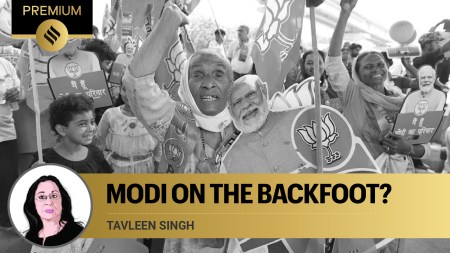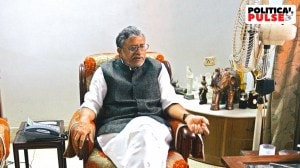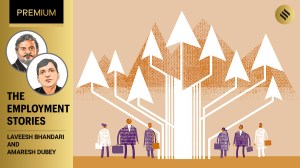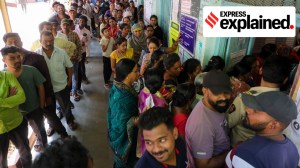- India
- International
The less cash budget
Proposals add up to a series of mutually reinforcing moves to build a digital payments ecosystem.
 With crucial elections looming, Arun Jaitley played it cool and he played it safe.
With crucial elections looming, Arun Jaitley played it cool and he played it safe.
After the drama of demonetisation, the 2017-18 Union budget has been a decidedly sober affair. The budget speech, one of the longest in history, was short on game-changing ideas. The finance minister didn’t seem terribly perturbed by the gathering storm clouds worldwide: Populist surges in the US and Europe; a strengthening dollar and oil price uncertainties; prospects of trade or religious wars, maybe both. That the IMF has shaved off a full percentage point of India’s anticipated growth rate as the economic penalty for the November cash carnage did not seem to provoke much worry either.
Watch What Else Is Making News
With crucial elections looming, Arun Jaitley played it cool and he played it safe. There was the expected tilt towards expenditure on infrastructure, tax cuts for small enterprises and shots in the arm for rural households and the agricultural sector.
To me, the most interesting question, however, was about what the FM had in store for jumpstarting digital payments; after all, with the re-branding of the demonetisation fiasco as an initiative to make India a “less cash” society, this issue seemed to be the most pertinent feature of this budget.
While the proposals for the “digital” theme were hardly revolutionary, they add up to a series of mutually reinforcing moves to build up a digital payments ecosystem — and the government picked a solution to champion as a focal point. For this, and for leaving the drama of 2016 behind him, the finance minister gets high marks.
At the heart of the budget’s digital strategy is a plan to put a thumb on the scale for the government’s own payment app, Bharat Interface for Money (BHIM), that facilitates electronic transfers between bank accounts. BHIM users can now enter their 12-digit Aadhaar number to make payments. The recently introduced payment system has been buggy, but it has attracted 12.5 million people to download the app. The budget aims to get many more signed up with incentive schemes to bring different market participants together: One is a referral bonus for users and the second, a cash back scheme for merchants who accept the payment system.

Moreover, a merchant version of the Aadhaar Pay system will be launched soon. To stimulate adoption in different situations, the government plans to mandate digital payments at petrol stations, hospitals and universities. Cash transactions over Rs 3 lakh have been banned altogether. Moreover, the Indian Railways will no longer levy a service charge on train tickets booked online through the IRCTC website.
Add to all this the fact that the government is removing duties on point-of-sale devices and fingerprint readers and there are plans for 10 lakh point-of-sale machines to be introduced by banks by March and another 20 lakh Aadhaar-based point-of-sale machines by September this year. The budget also proposes a Payments Regulatory Board under the Reserve Bank of India to supervise and regulate payment and settlement systems. Tax benefits to start-ups, relaxing the shareholding conditions for carry-forward of losses and other tax incentives are intended to stimulate entrepreneurial activity to round out the digital ecosystem. The budget allocates Rs 1.84 lakh crore for female skill development — any move to close the gender gap is a force multiplier in closing other gaps, both socio-economic and digital.
The budget also makes room for some relevant infrastructure investment: Broadband connectivity to 1,50,000 gram panchayats by the end of 2017-18 under BharatNet along with a DigiGaon initiative to be launched to provide tele-medicine, education and skills through digital technology. Overall, the government’s target is to achieve 25 billion digital transactions in 2017-18.
While I am generally of the belief that governments should not be in the business of picking technology winners, in this instance, I think it is smart for the Indian government to choose where to play and use its leverage to reinforce the ecosystem around the choice. Much about BHIM is appealing. It is relatively simple to use and based on the Unified Payments Interface (UPI) technology, which allows for bank-to-bank and bank-to-e-wallet payments without concerns about inter-operability. Currently, there are five payment options on the BHIM app; the Aadhaar number will be the sixth. There is no need for internet connectivity or a smartphone. In other words, it is an inclusive solution and, if done right, with the bugs fixed, it stands a chance of scaling up to Indian proportions.
What, you may ask, do the mobile wallet players, such as Paytm and Mobikwik, get out of this budget, given that they had turned out to be the heroes for the digitally enabled, during the dark days of demonetisation. Surely they must be feeling a little left out of all this talk of BHIM, as must the other UPI-based solutions. With the market still nascent and with plenty of headroom for growth, however, a strategy that builds a trustworthy digital payments ecosystem and educates consumers could create benefits for all digital payment players.
Yet, the budget could have been less sober on some key issues. If the strategy is successful, with a growing volume of digital transactions, the potential for cyberattacks increases dramatically. While the budget does provide for a Computer Emergency Response Team for the financial sector, which would work in close coordination with all financial sector regulators and other stakeholders, more scenarios could have been anticipated and more resources allocated to bolster cyber defences.
The second worry is about the current state of security of Aadhaar-based payment systems. The applications will use the biometric details registered in the Aadhaar card system. Even top-of-the-line fingerprint scanners can be fooled. Fingerprint data can be stolen. Technology against this is being developed but is far from being fool-proof.
Despite these concerns, India presents an attractive setting to build up the right digital ecosystem and environment. If done right, digital behaviour will follow. In a first-of-its-kind study of “digital trust” around the world that we are currently conducting at The Fletcher School, in collaboration with Mastercard, we find that out of 40 countries studied, India ranks 36th in the quality of consumer experience and trustworthiness of the digital environment, as measured by security, accountability and privacy features. In other words, there is a lot of ground to cover in creating a trustworthy environment and enhancing consumer experience. Interestingly, in terms of how tolerant consumers are to all the frictions in the digital system, we find the Indian consumer in the middle of the pack — 24th out of 40 countries. The pattern seems clear:
The Indian consumer is both patient and adaptable and is likely to give the government and the providers room to improve.
This budget is a step in the right direction. It takes a systemic view of the inter-connected incentives that must be orchestrated to engender trust, encourage adoption and develop a longer-lasting habit that gets the cash-loving Indian to budge. When compared to the scorched earth approach of demonetisation, the budget is decidedly a nudge approach. Experience with digital adoption in other situations suggests that the smartly placed nudge wins the budge.
The writer is the Senior Associate Dean of International Business & Finance at The Fletcher School at Tufts University and Non-Resident Senior Fellow of Brookings India. He is author of ‘The Slow Pace of Fast Change’
40 Years Ago
EXPRESS OPINION
Best of Express
More Explained
May 14: Latest News
- 01
- 02
- 03
- 04
- 05









































